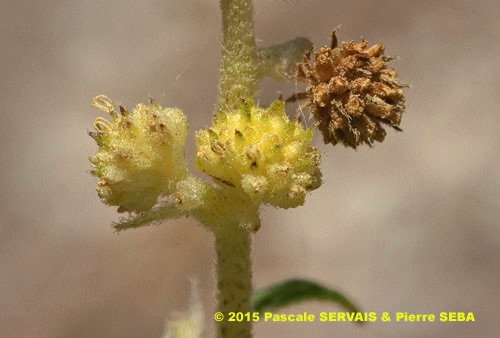
Xanthium strumarium L.
Fam. : Asteraceae
© Pascale SERVAIS & Pierre SEBA, 2018. Tilo Botanica: Flore de Tilos et du Dodécanèse / Flora of Tilos and of the Dodecanese
English translation by Brenda Bradbury, Howard Bradbury and Stéphane Léonard
Plante herbacée, hermaphrodite, robuste, à tiges érigées, généralement ramifiées vers la base, poilues.
Feuilles alternes, ovales à cordiformes, palmatilobées, à 3 à 5 lobes dentés, longuement pétiolées, à petits poils raides, sans épines à la base des feuilles.
Fleurs verdâtres, minuscules, à fleurons tous tubulés, réunies en capitules axillaires de 5 à 6 mm de diamètre. Capitules unisexués: capitules mâles globuleux au-dessus des capitules femelles ovoïdes et à 2 fleurs insignifiantes insérées dans un involucre. Bractées de l’involucre droites ou à épines crochues, s’agrandissant à la fructification. Ovaire infère.
Fruits, akènes jaune verdâtre, oblongs, de 25 à 30 mm de long, couverts de poils et d’épines crochues.
___________________________
Plant herbaceous, hermaphrodite, robust. Stems erect, hairy, generally branched towards the base.
Leaves alternate, ovate to heart-shaped, palmatilobate, with 3 to 5 toothed lobes, lengthily petiolate, with small stiff hairs, without thorns at the base of the leaves.
Flowers greenish, tiny, with only disk-florets, joined together in axillary capitula from 5 to 6 mm in diameter. Capitula unisexual: male capitula globose above ovoid female capitula and with 2 insignificant flowers inserted in an involucre. Bracts of the involucre straight or with hooked thorns, increasing at fructification. Ovary inferior.
Fruits, greenish yellow, oblong achenes, from 25 to 30 mm long, covered in hairs and in hooked thorns.
Descripteurs / Identifying features
1
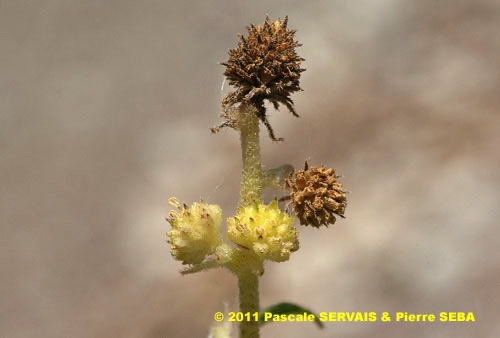
2
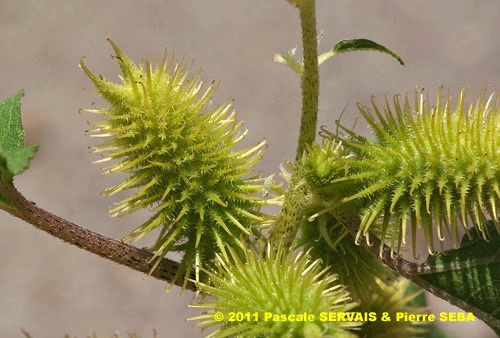
3
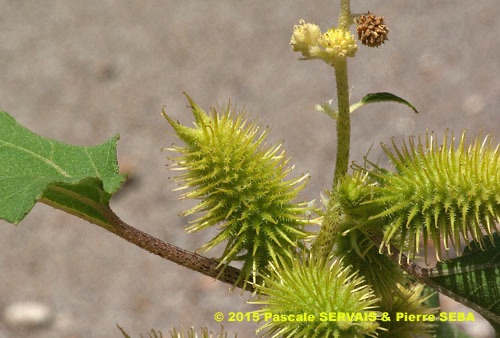
4
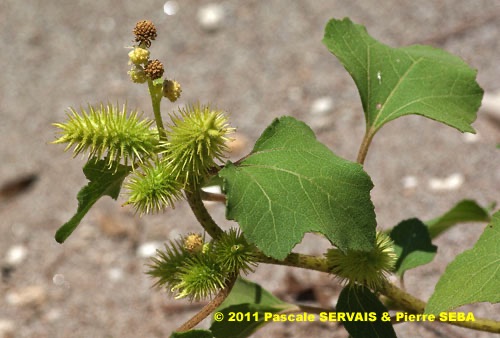
5
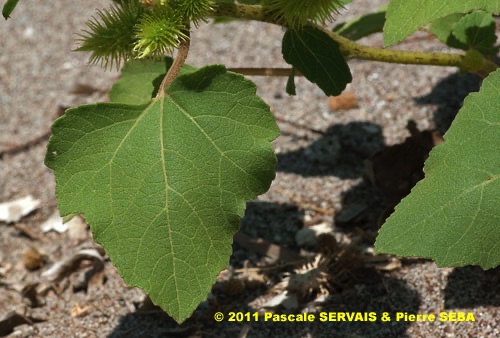
6
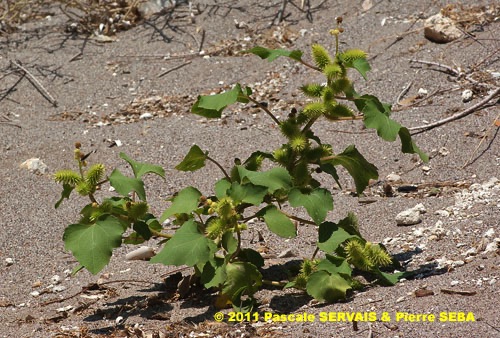
7
Étymologie / Etymology :
Xanthium : emprunt du latin xanthium, -i (nom) = la lampourde, nom
donné à la plante par Pline, naturaliste latin mort en 79 apr. J.-C.,
forme latinisée du grec ancien ξάνθιον, -ου (nom)
[ < ξανθός, -ή, -όν (adj.) = jaune ] = la lampourde, nom donné à la
plante par Dioscoride, médecin et botaniste grec mort en 90 apr. J.-C.,
en référence à la présence dans la plante d’un colorant jaune utilisé
pour teindre les cheveux en blond.
Strumarium : emprunt du latin médiéval strumarius, -a, -um (adj.)
[ < struma, -ae (nom) = le gonflement, la tumeur ] = qui présente des
pustules, en référence à la réputation qu’a la plante de guérir les
abcès.
Xanthium : borrowed from Latin xanthium, -i (noun) = cocklebur, name
given to the plant by Plinius, Latin naturalist died in 79 AD, Latinized
form of the Classical Greek ξάνθιον, -ου (noun) [ < ξανθός, -ή, -όν
(adj) = yellow ] = cocklebur, name given to the plant by Dioscorides,
Greek doctor and botanist died in 90 AD, referring to the presence in
the plant of a yellow dye used to dye hair in blond.
Strumarium : borrowed from medieval Latin strumarius, -a, -um (adj)
[ < struma, -ae (noun) = swelling, tumour ] = which has pustules,
referring to the plant's reputation to heal abscesses.
Synonymes / Synonyms :
Xanthium brasilicum Vell.
Xanthium fuscescens Jord. & Fourr.
Xanthium inerme Gray
Xanthium revelieri Jord. & Fourr.
Xanthium strumarium var. albertii Rouy
Xanthium strumarium var. fuscescens (Jord. & Fourr.) Rouy
Xanthium strumarium var. revelieri (Jord. & Fourr.) Rouy
Xanthium vulgare Lam.
Noms vernaculaires / Common names :
Noms français / French names :
Glouteron — Herbe aux écrouelles — Lampourde glouteron —
Petite bardane.
Noms grecs / Greek names :
Αγριομελιτζάνα — Αγριομπαμπακιά — Κολιτσίδα — Κολλητσίδα —
Μεγάλη κολλιτσίδα — Ξάνθιο.
Noms anglais / English names :
Burweed — Canada cocklebur — Rough cocklebur.
Noms allemands / German names :
Gemeine Spitzklette — Gewöhnliche Spitzklette.
Nom espagnol / Spanish name :
Cardillo común.
Nom italien / Italian name :
Nappola minore.
Habitat :
Lieux incultes - Lieux humides, mares - Sols sableux - Chemins.
Waste ground - Damp places, ponds - Sandy soils - Waysides.
Île / Island :
Tilos.
Hauteur / Height range :
De 30 cm à 1 m.
From 30 cm to 1 m.
Floraison / Flowering time :
De juin à septembre.
From June to September.
Groupe / Classification :
Dicotylédones.
Dicotyledons.
Pérennité / Lifespan :
Annuelle.
Annual.
Description :
Photo 1 :
Localisation / Location : Tilos, Megalochorio, Erystos
Date : 10/06/2011
GPS : Lat. 36,43339° N / Long. 27,34949° E / Alt. 3 m
Type : Photographie numérique / Digital Photograph (10 mégapixels)
Photo 2 :
Localisation / Location : Tilos, Megalochorio, Erystos
Date : 10/06/2011
GPS : Lat. 36,43339° N / Long. 27,34949° E / Alt. 3 m
Type : Photographie numérique / Digital Photograph (10 mégapixels)
Photo 3 :
Localisation / Location : Tilos, Megalochorio, Erystos
Date : 10/06/2011
GPS : Lat. 36,43339° N / Long. 27,34949° E / Alt. 3 m
Type : Photographie numérique / Digital Photograph (10 mégapixels)
Photo 4 :
Localisation / Location : Tilos, Megalochorio, Erystos
Date : 10/06/2011
GPS : Lat. 36,43339° N / Long. 27,34949° E / Alt. 3 m
Type : Photographie numérique / Digital Photograph (10 mégapixels)
Photo 5 :
Localisation / Location : Tilos, Megalochorio, Erystos
Date : 10/06/2011
GPS : Lat. 36,43339° N / Long. 27,34949° E / Alt. 3 m
Type : Photographie numérique / Digital Photograph (10 mégapixels)
Photo 6 :
Localisation / Location : Tilos, Megalochorio, Erystos
Date : 10/06/2011
GPS : Lat. 36,43339° N / Long. 27,34949° E / Alt. 3 m
Type : Photographie numérique / Digital Photograph (10 mégapixels)
Photo 7 :
Localisation / Location : Tilos, Megalochorio, Erystos
Date : 10/06/2011
GPS : Lat. 36,43339° N / Long. 27,34949° E / Alt. 3 m
Type : Photographie numérique / Digital Photograph (10 mégapixels)

Google Maps
Google Maps
Google Maps
Google Maps
Google Maps
Google Maps
Google Maps